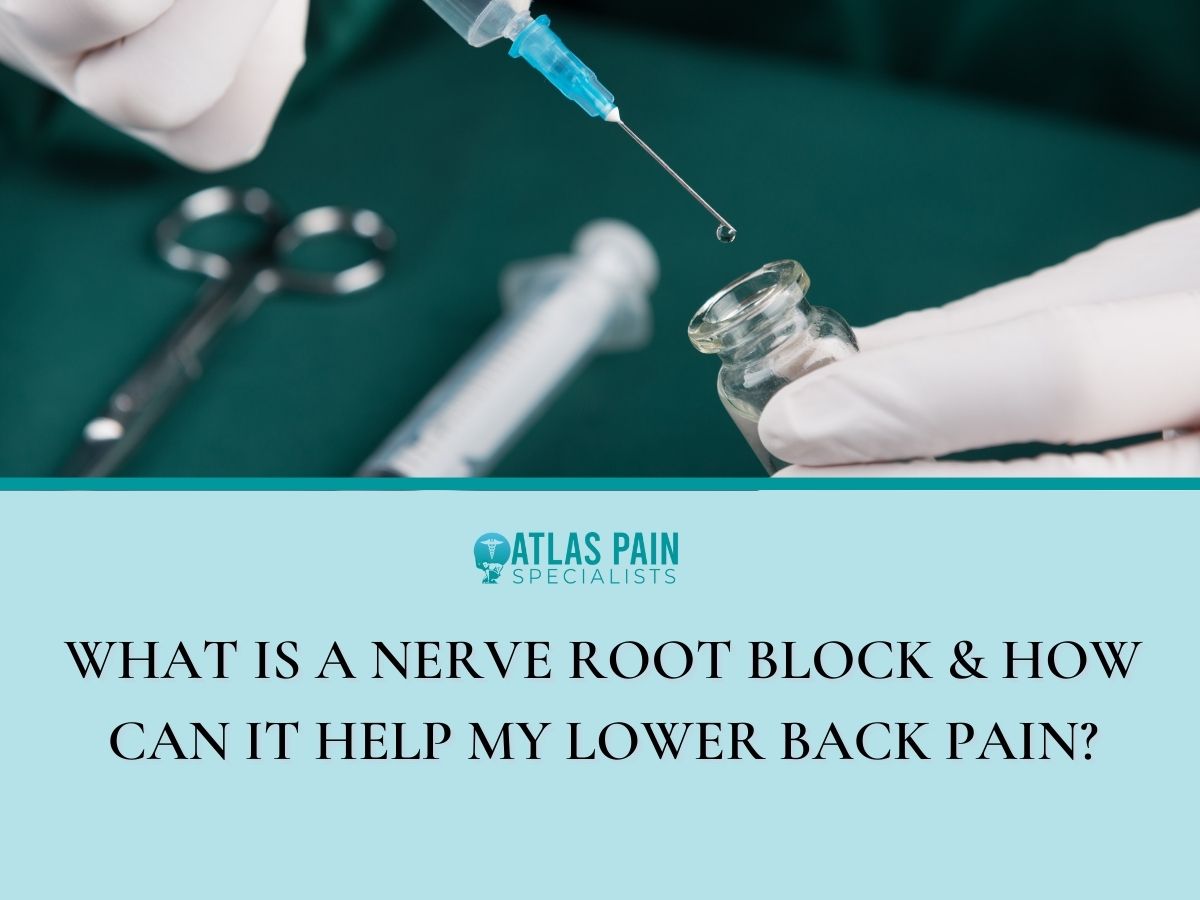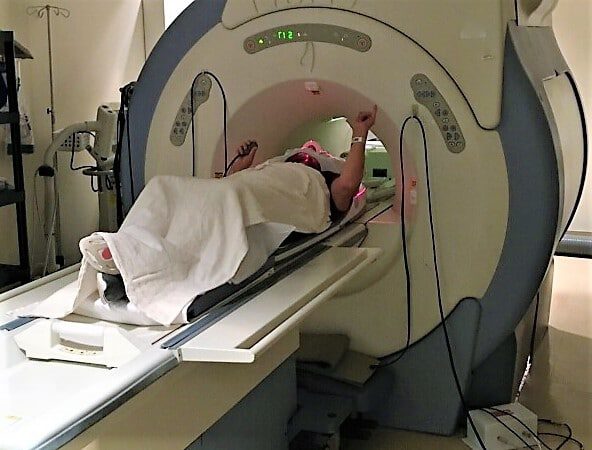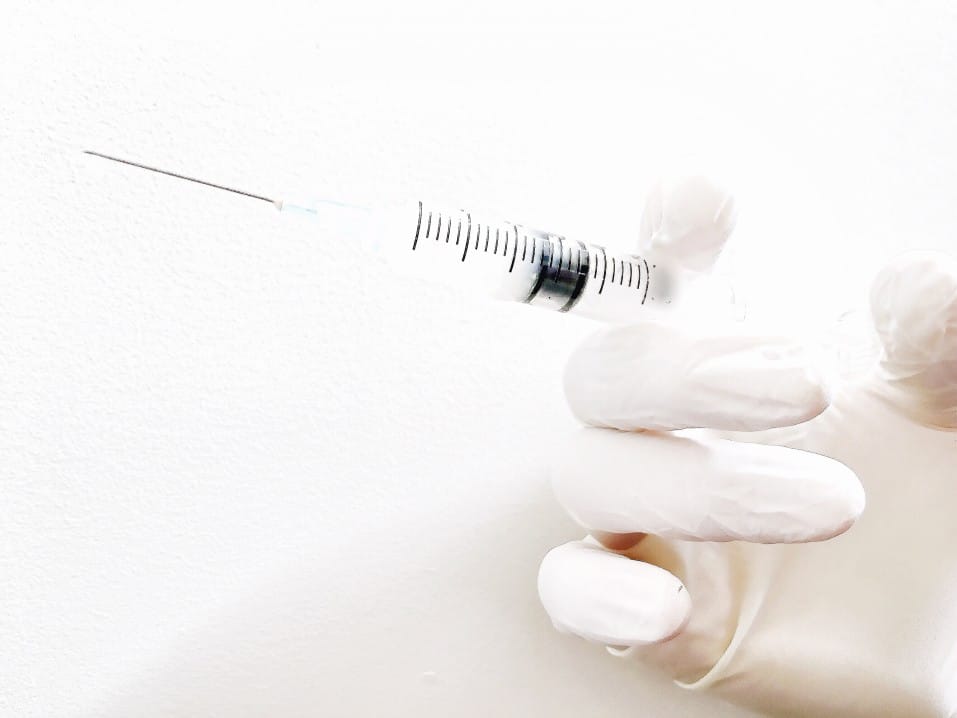

What Is A Nerve Root Block & How Can It Help My Lower Back Pain?
If you have chronic pain or inflammation, a nerve root block is an injection that can help you by "turning off" the pain signals that travel along with a specific distribution of nerves.
It allows a damaged nerve to heal over time, allowing the patient to experience pain reduction. It also aids in the identification of a more specific source of pain by temporarily numbing nerves in a specific area of inflammation for a short time.
It is estimated that 2 million Americans suffer from nerve pain, so around 2% of the population.
Some Causes of Nerve Root Pain
A variety of factors can trigger back pain.
- Disc herniation
- Spinal stenosis
- Physical conditions such as unusual bone growth and bone spurs
- Mechanical spinal injury or infection
- Spondylosis (deterioration of the spinal discs with age)
The nerve root block injection
Pain relief is provided by the injection, which contains a local anesthetic and a steroid directed at the affected area. It can alleviate acute or chronic back pain, depending on the situation. Usually used to help with:
- Lower Back Pain
- Sciatica (Pain shooting into your legs)

How should I prepare for the procedure?
It does not require any special preparation and is performed as an outpatient procedure that takes no more than 2 hours (sometimes less). This includes the time needed for the post-treatment check-up, which may take up to one hour.
Depending on the doctor's recommendation, some patients may be required to be admitted, and you should consult with your doctor to ensure that you are adequately prepared.
Make arrangements for someone to drive you home. After receiving a nerve root block, you should avoid driving for at least 24 hours after the procedure is completed.
Inform your doctor of any current prescriptions and allergies you are experiencing. This will assist in determining the most appropriate procedure for the injection to avoid complications.
Some anxious patients may require sedation. If this is the case, you must meet a few requirements, such as not eating for 6 hours before the surgery.
You will often be asked to use the restroom before the procedure and will be provided with a gown to wear for your convenience during the procedure.
Depending on the doctor's instructions, you will lie on your stomach or your side on a fluoroscopy or CT table.
Before, during, and after the procedure, the operator will ensure that you are in a comfortable position for the entire time.
How is the injection done?
The doctor uses imaging guidance such as fluoroscopy, ultrasound, and computed tomography (CT) scan to guide the needle to the correct diagnosed area.
An anesthetic is injected into the area where the needle will be administered to numb the area. The injection site is thoroughly cleaned during the procedure before injecting the medicine to avoid infection.
Which equipment is used during the injection?
A procedure performed under the guidance of imaging techniques requires the use of additional equipment. The imaging procedure is painless, and it allows the doctor to pinpoint the location where the injection should be administered.
The injection is performed with a needle similar to those used in most injections, and a small amount of contrast dye may be used to confirm that the needle is in the correct first position.
The use of fluoroscopy (live X-ray) involves using one or two x-ray tubes and a monitor, with the tubes and detector being suspended above the table.
The CT scanner has a donut-shaped design, with a table that slides in and out of a short tunnel. It revolves around you providing imaging to a technician working at an external workstation on the other side of the room.

Some Common Types of Nerve Root Block Injections
For the treatment of back pain, several kinds of nerve root injections can be utilized.
1. Selective nerve root block
This procedure is used to determine the source of pain by numbing specific nerves to isolate it.
Since pain returns after the numbing agent wear off, it is strictly a diagnostic procedure rather than one that can treat the condition.
Radicular pain is characterized by pain that originates from a single nerve root.
2. Nerve root injection
This is a pain-relieving treatment injection that is administered to patients. It entails injecting steroids and anesthetics directly into the nerves causing the pain.
Steroids used for nerve blocking work by:
- Decreasing nerve permeability, hence less blood is received in the nerve cells, therefore reducing pain signal transmission.
- Blocking specific fibers within the nerve effectively reduces pain signals sent to the brain.
- Inhibiting the action of certain enzymes that cause neural pain.
Procedure
The patient is placed in a comfortable position, usually on their side or lying on their stomach, depending on where the injection will be administered. Before, during, and after the procedure, the patient's comfort is essential to the procedure's success.
To prevent infection, the skin around the injection site is cleaned before the injection.
The area is first numbed, after which a contrast dye may be injected to determine whether the needle has been positioned correctly.
The use of imaging guidance to locate the nerve and guide the injection is necessary because every patient is unique in their anatomical makeup. Fluoroscopy (live X-ray) is frequently employed.
Even though the injection site has been numbed, some discomfort may be experienced when the needle is injected, resulting in the patient experiencing the same pain as before.
3. Dorsal root ganglion block
In this procedure, the dorsal root ganglion is injected with a local anesthetic and steroids, and the nerve root is effectively blocked.
The dorsal root ganglion is the area of a spinal nerve that connects to the spine and is located at the base of the spine. Its primary function is to transmit convey information from external or internal sites of the body such as actual or potential harm, temperature, or muscle length to the central nervous system.

4. Transforaminal lumbar epidural steroid injection
This is the injection of corticosteroids into the epidural space.
The lumbar epidural space is surrounding the dura, which serves as a protective covering for the spinal cord and is located in the lower back region.
Various factors can cause an inflammatory reaction of the nerves in the lumbar epidural space.
Most patients feel relief within 30 minutes but after a few hours, the pain will come back because the anesthetic wears off. After a few days, the steroids will begin to work thus bringing pain relief.
Causes:
Disk herniation
Soft discs cushion the spinal vertebrae. They are located in the space between the vertebrae and hold the bones together and control motion.
If a disk ruptures, the disk's contents may leak out and cause inflammation of the nerve roots. If the disk also slips out or bulges, it may cause pain.
Bone spurs
Osteophytes are bone growths that aren't painful but cause pain to the adjacent structures. They may pinch the nerve fibers in the spinal cord, causing pain.
Narrowing of the spine or spinal stenosis, herniated disks, and bone spurs may lead to a condition known as sciatica. This pain radiates along the sciatic nerve and commonly causes pain on one side of the body.
Post injection, what next?
The patient is kept in the hospital for approximately an hour following a nerve injection for follow-up tests.
This is done to determine whether or not the injection was successful and whether any complications occurred due to the procedure.
These may include
- Hemorrhage
Arteries or veins may be punctured due to the sensitive location of the nerve roots, resulting in internal bleeding. This may cause tissue damage as well.
This can be avoided by using imaging to guide the injection and injecting contrast dye to ensure that the medicine is delivered to the correct location.
- Nerve damage
Because the procedure entails actively injecting the treatment close to the nerve roots, the needle may damage the nerve clusters. In some cases, this may go unnoticed because of the injection of numbing agents, which mask the nerve damage.
Guidance during the injection is also an effective method of reducing the risk of nerve injury.
- Allergic reactions to some medications used
Make sure to tell your doctor about any medication allergies you have and any current prescriptions to avoid this.
Before the procedure, you may need to stop taking certain medications, such as blood-thinning medications, because they will interfere with the blood clotting process.
Once a patient has been discharged, they are not permitted to engage in any strenuous activity resulting in further nerve damage.
The nerve block provides a healing window for the damaged nerve while also preventing the patient from experiencing the pain associated with the procedure.
Although the area is numb, the patient may experience some discomfort, mainly as the injection is administered.
There may also be some side effects that manifest themselves later on.
- Headaches
- Loss of feeling in some areas
- Nausea
- Dizziness
Although the pain may appear to worsen over the next few days, this is primarily due to the anesthetic that was injected wearing off. Most patients will experience some level of pain relief within a few days of beginning treatment.
If the pain does not subside after a few days, you should consult your doctor about other treatment options. Alternatively, the same injection may be repeated a few more times to provide additional long-lasting pain relief.
The limitations of nerve blocks
The effectiveness of nerve blocks varies from one patient to the next, depending on the situation.
It is a temporary form of pain relief that works for some patients but not for others, although they have received multiple injections.
If the first treatment fails to relieve your back pain, your doctor may recommend another course of action.
Frequently asked questions
How do I know I have nerve root inflammation?
If you have pain in your lower back that travels down your legs when you bend your back, you may have an inflamed nerve. Increased sensitivity, tingling, and numbness in specific areas of the body may also be a sign.
Is there an alternative treatment for back pain?
Dorsal root ganglion stimulation therapy (DRG therapy) is a type of stimulation therapy used to treat chronic back pain in the lower back. The treatment is directed at specific DRGs that are responsible for back pain.
In this procedure, a small device known as a generator is implanted in the patient's body, with leads that carry impulses from the generator to the DRG. With the help of a patient controller, you can adjust the intensity of the stimulation or even turn it off completely.
This is a benefit when participating in strenuous activities because it allows you to adjust the pain level to a manageable level.
This is a service that we provide at Atlas Pain Specialists. Visit us today if you want to know more about it.
Where can I get a nerve block injection?
Our back pain specialists at Atlas Pain Specialists can provide you with a diagnosis and pain management treatment tailored to your specific needs.
Make a time to meet with us at our office as soon as possible!
About Dr. Sean Ormond



